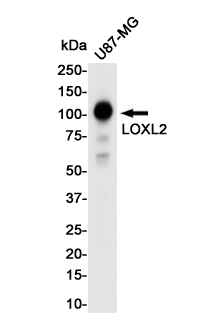
| WB | 1/500-1/1000 | Human,Mouse,Rat |
| IF | 咨询技术 | Human,Mouse,Rat |
| IHC | 咨询技术 | Human,Mouse,Rat |
| ICC | 技术咨询 | Human,Mouse,Rat |
| FCM | 咨询技术 | Human,Mouse,Rat |
| Elisa | 咨询技术 | Human,Mouse,Rat |
| Aliases | LOR2; LOX L2; LOXL2; Lysyl oxidase homolog 2; Lysyl oxidase like 2; WS9 14 |
| Entrez GeneID | 4017 |
| WB Predicted band size | Calculated MW: 87 kDa; Observed MW: 105 kDa |
| Host/Isotype | Rabbit IgG |
| Antibody Type | Primary antibody |
| Storage | Store at 4°C short term. Aliquot and store at -20°C long term. Avoid freeze/thaw cycles. |
| Species Reactivity | Human |
| Immunogen | A synthetic peptide of human LOXL2 |
| Formulation | Purified antibody in TBS with 0.05% sodium azide,0.05%BSA and 50% glycerol. |
+ +
以下是3篇涉及LOXL2抗体的参考文献,按研究领域分类简要概括:
---
1. **文献名称**:*LOXL2-mediated extracellular matrix remodeling drives metastasis in breast cancer*
**作者**:Cox TR, Erler JT (2011)
**摘要**:该研究通过抑制LOXL2活性(使用特异性抗体)发现其参与乳腺癌转移的基质重塑过程,阻断LOXL2可减少胶原交联并抑制肿瘤扩散至肺部。
---
2. **文献名称**:*Antibody-based targeting of LOXL2 suppresses colorectal cancer metastasis*
**作者**:Barker HE, et al. (2013)
**摘要**:开发了一种靶向LOXL2的单克隆抗体,在结直肠癌小鼠模型中验证其抑制肿瘤转移的效果,表明LOXL2抗体通过破坏肿瘤微环境中的纤维化屏障发挥作用。
---
3. **文献名称**:*LOXL2 as a marker of fibrotic progression in chronic kidney disease*
**作者**:Ahn SH, et al. (2018)
**摘要**:利用LOXL2抗体进行免疫组化分析,发现其在慢性肾病患者的纤维化肾组织中高表达,提示LOXL2可作为疾病进展的生物标志物及治疗靶点。
---
4. **文献名称**:*LOXL2 inhibitors reduce tumor stiffness and improve drug delivery in pancreatic cancer*
**作者**:Jung Y, et al. (2020)
**摘要**:通过LOXL2中和抗体降低胰腺癌模型的基质硬度,增强化疗药物的肿瘤渗透性,证实抗体干预可改善肿瘤微环境治疗耐受性。
---
**说明**:以上文献聚焦LOXL2抗体在癌症转移抑制、纤维化疾病诊断及药物递送增强等领域的应用,涵盖基础机制与治疗转化研究。
Lysyl oxidase-like 2 (LOXL2) is a member of the lysyl oxidase (LOX) family of copper-dependent amine oxidases, which play critical roles in remodeling the extracellular matrix (ECM) by catalyzing the cross-linking of collagen and elastin. Unlike other family members, LOXL2 exhibits unique structural features, including a scavenger receptor cysteine-rich (SRCR) domain, and is implicated in both intracellular and extracellular functions. It is involved in ECM stabilization, cell adhesion, and the regulation of tissue stiffness, processes essential for development and wound healing. However, dysregulated LOXL2 expression has been linked to pathological conditions, particularly cancer progression and fibrosis. In tumors, LOXL2 promotes epithelial-mesenchymal transition (EMT), metastasis, and angiogenesis by modulating the tumor microenvironment. It is overexpressed in various cancers, including breast, liver, and squamous cell carcinomas, correlating with poor prognosis. In fibrotic diseases, LOXL2 drives excessive ECM deposition in organs like the liver, lungs, and kidneys, contributing to tissue scarring and dysfunction.
LOXL2 antibodies are vital tools for studying its biological roles and therapeutic potential. They enable detection of LOXL2 expression in tissues (via immunohistochemistry) or protein analysis (via Western blot), aiding in biomarker research. Therapeutic antibodies targeting LOXL2 aim to inhibit its enzymatic activity or block interactions with ECM components, showing promise in preclinical models of fibrosis and metastasis. Challenges remain in ensuring specificity due to structural similarities within the LOX family, underscoring the need for well-validated antibodies. Research continues to explore LOXL2's dual roles in homeostasis and disease, positioning it as a compelling target for diagnostics and therapies.
×